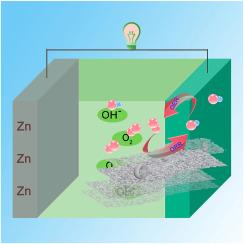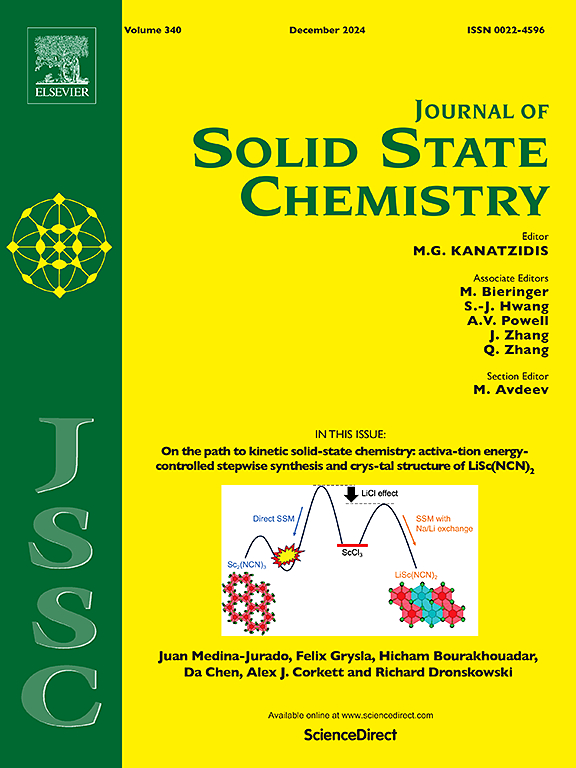可充电锌空气电池用过渡金属离子螯合COFs衍生双功能氧催化剂
IF 3.2
3区 化学
Q2 CHEMISTRY, INORGANIC & NUCLEAR
引用次数: 0
摘要
提高能量转换效率和电池循环稳定性是能量转换和存储的重要目标,而设计有效的双功能催化剂是实现这一目标的关键因素。共价有机骨架是一种新型的高分子材料,可作为定量螯合金属离子的理想模板,用于合成具有高分散金属活性位点的高效双功能催化剂。本研究以金属螯合COFs和MA/GO混合物为一级前驱体,结合高温热解策略,构建了Fe2Ni1/NiFe2O4@NCG双功能催化剂。COFs和MA作为螯合剂和间隔剂,改善了金属纳米颗粒的分散。Fe2Ni1/NiFe2O4@NCG复合材料具有较大的BET表面积和层次化结构,碳层上有丰富的纳米颗粒。HRTEM证实了FeNi和NiFe2O4的共存。最佳的Fe2Ni1/NiFe2O4@NCG-800复合材料表现出令人满意的O2催化性能,ORR的半波电位为0.857 V, OER的过电位为244 mV。同时,DFT计算证明,在FeNi与NiFe2O4结合后,在界面处发生了电子重分布。Fe2Ni1/NiFe2O4@NCG-based液态和固态ZAB表现优异,具有较大的比容量(水溶液ZAB为796 mAh·g−1;742 mAh·g−1固态ZAB)和稳定的充放电循环性能(300h水溶液ZAB;180 h(固态ZAB)。本文章由计算机程序翻译,如有差异,请以英文原文为准。

Transition metal ions-chelated COFs derived bifunctional oxygen catalysts for rechargeable Zn-air batteries
Improving energy conversion efficiency and battery cycle stability is an essential goal in energy conversion and storage, while a critical factor in achieving this goal is the design of effective bifunctional catalysts. The covalent organic framework is a new type of high molecular material that can be employed as an ideal template for quantitative chelate metal ions to synthesize highly efficient bifunctional catalysts with high dispersion metal active sites. In this work, the Fe2Ni1/NiFe2O4@NCG bifunctional catalysts are constructed by employing metal-chelated COFs and MA/GO mixture as primary precursors combined with a high-temperature pyrolysis strategy. COFs and MA serve as chelators and spacers to improve the dispersion of metal nanoparticles. The Fe2Ni1/NiFe2O4@NCG composite exhibits a large BET surface area and hierarchical structure with plentiful nanoparticles on the carbon layers. HRTEM proves the coexistence of FeNi and NiFe2O4. The optimal Fe2Ni1/NiFe2O4@NCG-800 composite shows satisfactory catalytic O2 performance, providing a half-wave potential of 0.857 V for ORR and an overpotential of 244 mV for OER. Meanwhile, DFT calculations prove that electron redistribution occurs at the interface between FeNi and NiFe2O4 after combination. The Fe2Ni1/NiFe2O4@NCG-based liquid and solid-state ZABs perform very well, exhibiting large specific capacities (796 mAh·g−1 for aqueous ZAB; 742 mAh·g−1 for solid-state ZAB) and stable charge-discharge cycle performance (300 h for aqueous ZAB; 180 h for solid-state ZAB).
求助全文
通过发布文献求助,成功后即可免费获取论文全文。
去求助
来源期刊

Journal of Solid State Chemistry
化学-无机化学与核化学
CiteScore
6.00
自引率
9.10%
发文量
848
审稿时长
25 days
期刊介绍:
Covering major developments in the field of solid state chemistry and related areas such as ceramics and amorphous materials, the Journal of Solid State Chemistry features studies of chemical, structural, thermodynamic, electronic, magnetic, and optical properties and processes in solids.
 求助内容:
求助内容: 应助结果提醒方式:
应助结果提醒方式:


